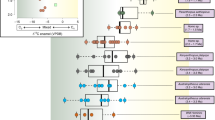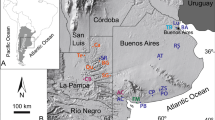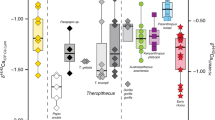Abstract
It has long been hypothesized that the transition from Australopithecus to Homo in eastern Africa was linked to the spread of open and arid environments near the Plio−Pleistocene boundary, but data for the latest Pliocene are scarce. Here we present new stable carbon isotope data from the late Pliocene mammalian fauna from Ledi-Geraru, in the lower Awash Valley (LAV), Ethiopia, and mammalian community analyses from the LAV and Turkana Basin. These data, combined with pedogenic carbonate stable isotopes, indicate that the two regions were largely similar through the Plio−Pleistocene, but that important environmental differences existed during the emergence of Homo around 2.8 million years ago. The mid-Pliocene to late Pliocene interval in the LAV was characterized by increasingly C4-dominated, arid and seasonal environments. The early Homo mandible LD 350-1 has a carbon isotope value similar to that of earlier Australopithecus from the LAV, possibly indicating that the emergence of Homo from Australopithecus did not involve a dietary shift. Late Pliocene LAV environments contrast with contemporaneous environments in the Turkana Basin, which were more woody and mesic. These findings have important implications for the environmental conditions surrounding the emergence of Homo, as well as recent hypotheses regarding Plio−Pleistocene environmental change in eastern Africa.
This is a preview of subscription content, access via your institution
Access options
Access Nature and 54 other Nature Portfolio journals
Get Nature+, our best-value online-access subscription
$29.99 / 30 days
cancel any time
Subscribe to this journal
Receive 12 digital issues and online access to articles
$119.00 per year
only $9.92 per issue
Buy this article
- Purchase on Springer Link
- Instant access to full article PDF
Prices may be subject to local taxes which are calculated during checkout



Similar content being viewed by others
References
DeMenocal, P. B. Plio-Pleistocene African climate. Science 270, 53–59 (1995).
DeMenocal, P. B. African climate change and faunal evolution during the Pliocene–Pleistocene. Earth Planet. Sci. Lett. 220, 3–24 (2004).
Bobe, R. & Behrensmeyer, A. K. The expansion of grassland ecosystems in Africa in relation to mammalian evolution and the origin of the genus Homo. Palaeogeogr. Palaeoclimatol. Palaeoecol. 207, 399–420 (2004).
Vrba, E. S. Environment and evolution: alternative causes of the temporal distribution of evolutionary events. S. Afr. J. Sci. 81, 229–236 (1985).
Vrba, E. S. in Evolutionary History of the “Robust” Australopithecines (ed. Grine, F. E. ) 405–426 (Transaction, 1988).
Bobe, R., Behrensmeyer, A. K., Eck, G. G. & Harris, J. M. in Hominin Environments in the East African Pliocene: An Assessment of the Faunal Evidence (eds Bobe, R., Alemseged, Z. & Behrensmeyer, A. K.) 129–158 (Springer, 2007).
Levin, N. E., Brown, F. H., Behrensmeyer, A. K., Bobe, R. & Cerling, T. E. Paleosol carbonates from the Omo Group: isotopic records of local and regional environmental change in East Africa. Palaeogeogr. Palaeoclimatol. Palaeoecol. 307, 75–89 (2011).
Levin, N. E. Environment and climate of early human evolution. Annu. Rev. Earth Planet. Sci. 43, 405–429 (2015).
Wood, B. A. & Leakey, M. G. The Omo-Turkana Basin fossil hominins and their contribution to our understanding of human evolution in Africa. Evol. Anthropol. 20, 264–292 (2011).
Bobe, R. Fossil mammals and paleoenvironments in the Omo-Turkana Basin. Evol. Anthropol. 20, 254–263 (2011).
Johanson, D. C., Taieb, M. & Coppens, Y. Pliocene hominids from the Hadar Formation, Ethiopia (1973–1977): stratigraphic, chronologic, and paleoenvironmental contexts, with notes on hominid morphology and systematics. Am. J. Phys. Anthropol. 57, 373–402 (1982).
Frost, S. R. & Delson, E. Fossil Cercopithecidae from the Hadar Formation and surrounding areas of the Afar Depression, Ethiopia. J. Hum. Evol. 43, 687–748 (2002).
Reed, K. E. Paleoecological patterns at the Hadar hominin site, Afar regional state, Ethiopia. J. Hum. Evol. 54, 743–768 (2008).
DiMaggio, E. N. et al. Late Pliocene fossiliferous sedimentary record and the environmental context of early Homo from Afar, Ethiopia. Science 347, 1355–1359 (2015).
Villmoare, B. et al. Early Homo at 2.8 Ma from Ledi-Geraru, Afar, Ethiopia. Science 347, 1352–1355 (2015).
Kingston, J. D. Shifting adaptive landscapes: progress and challenges in reconstructing early hominid environments. Am. J. Phys. Anthropol. 134, 20–58 (2007).
Levin, N. E., Haile-Selassie, Y., Frost, S. R. & Saylor, B. Z. Dietary change among hominins and cercopithecids in Ethiopia during the early Pliocene. Proc. Natl Acad. Sci. USA 112, 12304–12309 (2015).
Wynn, J. G. et al. Dietary flexibility of Australopithecus afarensis in the face of paleoecological change during the middle Pliocene: evidence from Hadar, Ethiopia. J. Hum. Evol. 99, 93–106 (2016).
Cerling, T. E., Chritz, K. L., Jablonski, N. G., Leakey, M. G. & Manthi, F. K. Diet of Theropithecus from 4 to 1 Ma in Kenya. Proc. Natl Acad. Sci. USA 110, 10507–10512 (2013).
Wynn, J. G. et al. Diet of Australopithecus afarensis from the Pliocene Hadar formation, Ethiopia. Proc. Natl Acad. Sci. USA 110, 10495–10500 (2013).
Negash, E. W., Alemseged, Z., Wynn, J. G. & Bedaso, Z. K. Paleodietary reconstruction using stable isotopes and abundance analysis of bovids from the Shungura Formation of South Omo, Ethiopia. J. Hum. Evol. 88, 127–136 (2015).
McDougall, I. et al. New single crystal 40Ar/39Ar ages improve time scale for deposition of the Omo Group, Omo–Turkana Basin, East Africa. J. Geol. Soc. London 169, 213–226 (2012).
Cerling, T. E. et al. Dietary changes of large herbivores in the Turkana Basin, Kenya from 4 to 1 Ma. Proc. Natl Acad. Sci. USA 112, 11467–11472 (2015).
Fortelius, M. et al. An ecometric analysis of the fossil mammal record of the Turkana Basin. Phil. Trans. R. Soc. B 371, 20150232 (2016).
Rowan, J. et al. Fossil Giraffidae (Mammalia, Artiodactyla) from Lee Adoyta, Ledi-Geraru, and late Pliocene dietary evolution in giraffids from the lower Awash Valley, Ethiopia. J. Mamm. Evol. http://dx.doi.org/10.1007/s10914-016-9343-z (2016).
Aronson, J. L., Hailemichael, M. & Savin, S. M. Hominid environments at Hadar from paleosol studies in a framework of Ethiopian climate change. J. Hum. Evol. 55, 532–550 (2008).
Levin, N. E., Quade, J., Simpson, S. W., Semaw, S. & Rogers, M. Isotopic evidence for Plio–Pleistocene environmental change at Gona, Ethiopia. Earth Planet. Sci. Lett. 219, 93–110 (2004).
Quade, J. et al. Paleoenvironments of the earliest stone toolmakers, Gona, Ethiopia. Geol. Soc. Am. Bull. 116, 1529–1544 (2004).
De Heinzelin, J. et al. Environment and behavior of 2.5-million-year-old Bouri hominids. Science 284, 625–629 (1999).
Heaton, T. Spatial, species, and temporal variations in the 13C/12C ratios of C3 plants: implications for palaeodiet studies. J. Archaeol. Sci. 26, 637–649 (1999).
O’Leary, M. H. Carbon isotope fractionation in plants. Phytochemistry 20, 553–567 (1981).
O’Leary, M. H. Carbon isotope photosynthesis. Bioscience 38, 328–336 (1988).
Cerling, T. E., Harris, J. M. & Passey, B. H. Diets of East African Bovidae based on stable isotope analysis. J. Mammal. 84, 456–470 (2003).
Kingston, J. D. in Paleontology and Geology of Laetoli: Human Evolution in Context (ed. Harrison, T. ) 293–328 (Springer, 2011).
Cerling, T. E. & Harris, J. M. Carbon isotope fractionation between diet and bioapatite in ungulate mammals and implications for ecological and paleoecological studies. Oecologia 120, 119–146 (1999).
Passey, B. H. et al. Carbon isotope fractionation between diet, breath CO2, and bioapatite in different mammals. J. Archaeol. Sci. 32, 1459–1470 (2005).
Reed, K. E. Early hominid evolution and ecological change through the African Plio-Pleistocene. J. Hum. Evol. 32, 289–322 (1997).
Reed, K. E. Using large mammal communities to examine ecological and taxonomic structure and predict vegetation in extant and extinct assemblages. Paleobiology 24, 384–408 (1998).
Hijmans, R. J., Cameron, S. E., Parra, J. L., Jones, P. G. & Jarvis, A. Very high resolution interpolated climate surfaces for global land areas. Int. J. Clim. 25, 1965–1978 (2005).
Wei, T. & Simko, V. Package ‘corrplot’: visualization of a correlation matrix. Matrix R Package v.0.77 (2016).
IBM Corp. IBM SPSS Statistics for Windows, version 24.0 (2016).
R Development Core Team R: A Language and Enviroment for Statistical Computing (R Foundation for Statistical Computing, 2014).
Sponheimer, M. et al. Isotopic evidence of early hominin diets. Proc. Natl Acad. Sci. USA 110, 10513–10518 (2013).
Feakins, S. J. et al. Northeast African vegetation change over 12 m.y. Geology 41, 295–298 (2013).
Acknowledgements
We thank the curators and staff of the Authority for Research and Conservation of Cultural Heritage at the Ethiopian National Museum in Addis Ababa, Ethiopia, for access to fossil specimens in their care. We thank the Afar people for assisting with fieldwork. Thanks to J. Wilson for helping to analyse samples at the University of South Florida. We thank M. Leakey for access to the most recent version of the Turkana Database. J.R. was supported by a National Science Foundation Graduate Research Fellowship. Field and lab work in the Ledi-Geraru area was made possible by National Science Foundation grant BCS-1157351. This research was also made possible through the support of a grant from the John Templeton Foundation to the Institute of Human Origins at Arizona State University. The opinions expressed in this publication are those of the authors and do not necessarily reflect the views of the John Templeton Foundation.
Author information
Authors and Affiliations
Contributions
J.R.R., J.R., C.J.C., J.G.W. and K.E.R. designed and performed the research, analysed the data and wrote the paper. All authors discussed the results and commented on the manuscript.
Corresponding author
Ethics declarations
Competing interests
The authors declare no competing financial interests.
Supplementary information
Supplementary Information
Supplementary Methods, Supplementary Discussion of the carbon and oxygen isotope results, Supplementary Figures, Supplementary Tables, and Supplementary References (PDF 3049 kb)
Supplementary Data 1
Raw values and catalogue numbers for all individual teeth included in this study. Taxonomic identifications and detailed descriptions for each tooth sampled are also included. (XLSX 22 kb)
Rights and permissions
About this article
Cite this article
Robinson, J., Rowan, J., Campisano, C. et al. Late Pliocene environmental change during the transition from Australopithecus to Homo. Nat Ecol Evol 1, 0159 (2017). https://doi.org/10.1038/s41559-017-0159
Received:
Accepted:
Published:
DOI: https://doi.org/10.1038/s41559-017-0159
This article is cited by
-
The effects of mid-to-late Pliocene climatic fluctuations on the habitat and distribution of early hominins
Human Ecology (2023)
-
Investigating Isotopic Niche Space: Using rKIN for Stable Isotope Studies in Archaeology
Journal of Archaeological Method and Theory (2022)
-
Intrataxonomic trends in herbivore enamel δ13C are decoupled from ecosystem woody cover
Nature Ecology & Evolution (2021)
-
New Remains of Camelus grattardi (Mammalia, Camelidae) from the Plio-Pleistocene of Ethiopia and the Phylogeny of the Genus
Journal of Mammalian Evolution (2021)
-
The palaeoecological context of the Oldowan–Acheulean in southern Africa
Nature Ecology & Evolution (2018)



